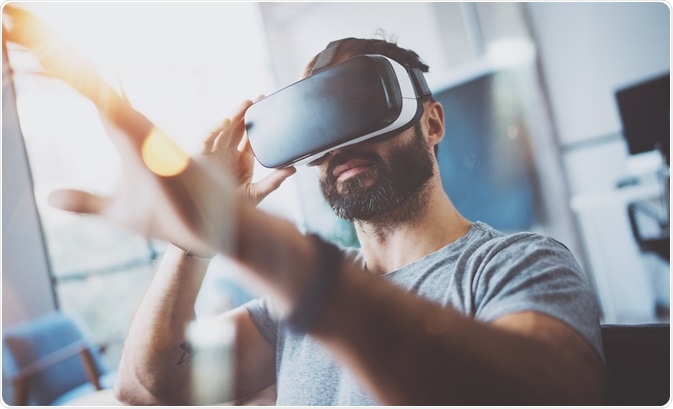Claustrophobia is a condition characterized by the development of unbearable anxiety in enclosed spaces or with physical restriction. Common triggers for claustrophobia include small rooms, elevators, crowded places, and MRI scanners. The symptoms of claustrophobia are typical anxiety symptoms. They can be mild, such as trembling and sweating. Symptoms can also be severe, such as rapid heartbeat, fainting, or panic attack.

Credit: Suttha Burawonk/ Shutterstock.com
Claustrophobia is an irrational fear, in that the affected individuals know they are not in danger in the triggering situation. The prevalence of severe claustrophobia is about 4% of the population. Many more people experience milder manifestations of claustrophobia. There are several possible approaches for treatment of claustrophobia.
Cognitive behavioral therapy
Cognitive behavioral therapy (CBT) is a mode of treatment based on the premise that psychological distress is maintained by maladaptive cognitions, or thoughts. Those maladaptive cognitions could include beliefs about the world, the self, or the future, resulting in certain automatic thoughts triggered by specific situations. Disorder-specific CBT protocols have been developed to address the thoughts and behaviors in various disorders, with the goal of reducing symptoms and improving functioning.
Claustrophobia is a manifestation of anxiety. CBT has been established as a reliable first-line approach for anxiety disorders and phobias. CBT is superior to placebo in treatment of generalized anxiety disorder, and equally as effective as relaxation therapy, supportive therapy, or psychopharmacology.
The techniques of CBT include challenging forms of distorted thinking such as all-or-nothing thinking, jumping to conclusions, disqualifying the positive, and so forth. Patients typically do homework assignments that involve practicing skills in daily life. Cognitive therapy is usually used to supplement exposure therapy for claustrophobia.
Exposure therapy
Exposure therapy is considered by some to be a form of CBT. Exposure therapy is based on emotional processing theory. That states that fear is represented by associative networks (or cognitive fear structures) that maintains information about fear triggers. The associative network activates in response to the fear stimulus.
Exposure to the trigger is introduced in order to activate the associative network and provide new information that disproves an unrealistic association. For instance, information could be given to prove that the stimulus is not dangerous. When the stimulus is confronted, corrective information is integrated into the network, and the fear should decrease.
Exposure can be through imagination, in real life, or interoceptive. Interoceptive exposure, primarily used for panic attacks, works by inducing physical sensations that are indicative of a panic attack.In vivo or real-life exposure is considered to be the most effective form of therapy for specific phobias, including claustrophobia.
Virtual reality
Virtual reality represents another novel approach on the horizon. In virtual reality exposure therapy (VRET), negative stimulus can be applied for exposure purposes that is less expensive and intimidating that exposure to the real stimulus. The goal of virtual reality systems is to invoke presence, eliciting an emotional response. In one study of a virtual reality exposure therapy prototype system, the system was effective in creating a sense of presence in triggering environments, and showed potential for future use in therapy. The VRET system also has potential for use with other psychological disorders.
Sources:
- The efficacy of cognitive behavioral therapy: a review of meta-analyses, https://www.ncbi.nlm.nih.gov/pmc/articles/PMC3584580/
- Cognitive-behavioral therapy for anxiety disorders: an update on the empirical evidence, https://www.ncbi.nlm.nih.gov/pmc/articles/PMC4610618/
- Viability of virtual reality exposure therapy as a treatment alternative, http://www.sciencedirect.com/science/article/pii/S0747563207000787
- A virtual reality claustrophobia therapy system – implementation and test, http://ieeexplore.ieee.org/abstract/document/4811020/?reload=true
- NHS, Claustrophobia, www.nhs.uk/conditions/claustrophobia/Pages/Introduction.aspx#Treating
Further Reading
- All Claustrophobia Content
- Claustrophobia Overview
- Claustrophobia and Panic Attacks
- Claustrophobia Triggers and Causes
- Claustrophobia Symptoms
Last Updated: Feb 26, 2019

Written by
Dr. Catherine Shaffer
Catherine Shaffer is a freelance science and health writer from Michigan. She has written for a wide variety of trade and consumer publications on life sciences topics, particularly in the area of drug discovery and development. She holds a Ph.D. in Biological Chemistry and began her career as a laboratory researcher before transitioning to science writing. She also writes and publishes fiction, and in her free time enjoys yoga, biking, and taking care of her pets.
Source: Read Full Article
